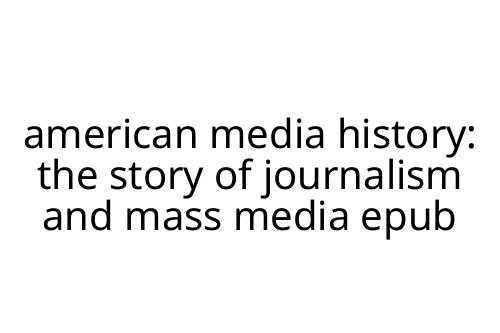american media history: the story of journalism and mass media epub
Understanding how information has shaped American society starts with a look at our news and media. The phrase “american media history: the story of journalism and mass media epub” might sound academic, but it’s a gateway into tracing the rise of the press, radio, television, and today’s digital networks. This article breaks down why this subject matters, what you’ll find in a typical resource like an epub on the topic, and why knowing media history is as relevant as ever.
Why Study American Media History?
Journalism didn’t always look the way it does now. Studying american media history shows us how newspapers, radio broadcasts, TV news, and online platforms evolved. Early journalism set the tone for American political debate and cultural identity. Understanding this timeline helps to explain why the media still wields significant influence over public opinion and government policy.
Looking back, you’ll see periods of sensationalism (“yellow journalism”), the era of objectivity, and the arrival of the 24-hour news cycle. Each chapter tells part of the broader story: who controls the flow of information, how stories are told, and how audiences are shaped.
What Does an “EPUB” Add to the Story?
The mention of “epub” signals a digital reading format—a convenient way to access comprehensive texts on media history. An epub version is lightweight, portable, and can be read on many devices. Good epubs cover everything from colonial pamphlets to current newsroom ethics. They offer embedded links and dynamic navigation, giving readers a smoother way to explore complicated timelines and profiles.
What’s Inside These Books?
Most epub titles about american media history: the story of journalism and mass media will cover:
- The beginnings of American journalism in the 1700s
- The emergence of national newspapers and broadcast networks
- The impact of wars, movements, and new technology
- The shift from print to digital news
- Discussion of landmark events, like Watergate or the advent of cable news
- Profiles of influential editors, reporters, and broadcasters
You’ll find pros and cons debated—how the First Amendment protected free speech, but also how bias and misinformation have always been part of the mix.
Practical Takeaways
- Context: Knowing american media history can help you spot trends or biases in coverage today.
- Source Awareness: Older scandals echo in today’s click-driven media environment—knowing the past helps keep perspective.
- Digital Reading: Using the epub format means you can quickly search terms, bookmark sections, and carry volumes of information in your pocket.
Pros and Cons of Digital Media Histories
Pros:
- Easy to access and search
- Portable and lightweight
- Often include multimedia or updated links
Cons:
- Screens aren’t for everyone
- Some epubs may lack visual context (photos, archival documents) found in print editions
Final Thoughts
Digging into american media history: the story of journalism and mass media epub gives readers context for today’s media debates. An ebook format makes this vast, evolving subject more accessible. Whether you’re a student, a media professional, or just curious about where our news comes from, understanding the long arc of journalism and mass communication in America pays off.


 Roger Estes has played a crucial role in the development of Residence Resale Tactics, bringing his analytical skills and attention to detail to the project. As a dedicated helper, Roger has been instrumental in researching emerging market trends and ensuring the platform stays ahead of the curve in providing up-to-date real estate information. His commitment to accuracy and relevance has been essential in creating a resource that real estate professionals and homeowners can rely on for practical guidance.
Roger's contributions go beyond just research; his proactive approach and collaborative spirit have fostered a productive working environment within the team. His efforts have helped shape the platform's strategic direction, allowing Residence Resale Tactics to deliver content that is both insightful and actionable, thereby enhancing its reputation as a trusted authority in the real estate industry.
Roger Estes has played a crucial role in the development of Residence Resale Tactics, bringing his analytical skills and attention to detail to the project. As a dedicated helper, Roger has been instrumental in researching emerging market trends and ensuring the platform stays ahead of the curve in providing up-to-date real estate information. His commitment to accuracy and relevance has been essential in creating a resource that real estate professionals and homeowners can rely on for practical guidance.
Roger's contributions go beyond just research; his proactive approach and collaborative spirit have fostered a productive working environment within the team. His efforts have helped shape the platform's strategic direction, allowing Residence Resale Tactics to deliver content that is both insightful and actionable, thereby enhancing its reputation as a trusted authority in the real estate industry.